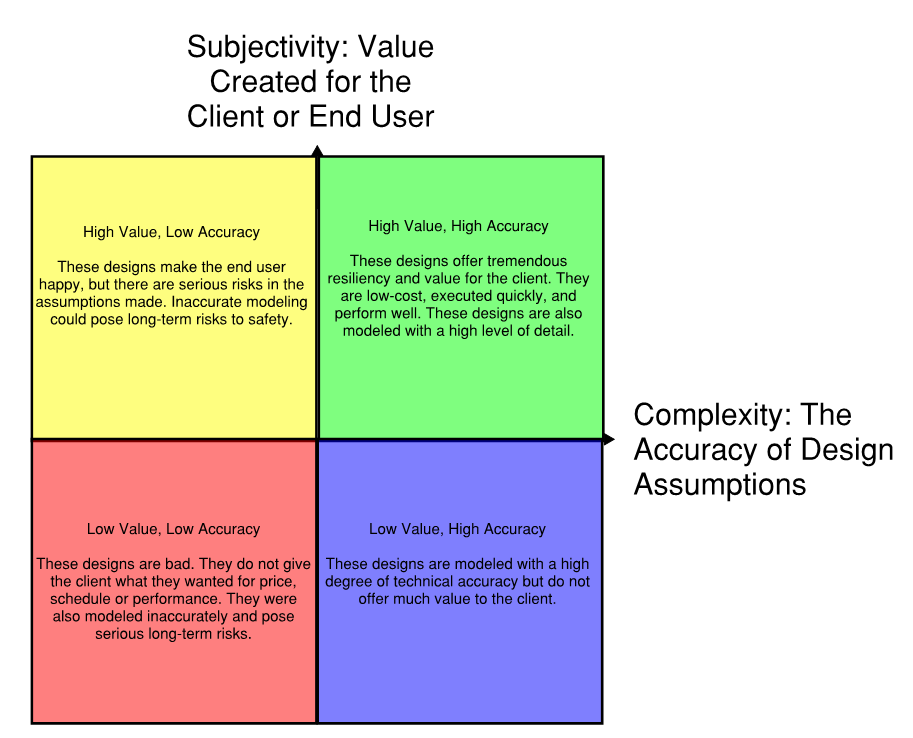Too many times have I heard an engineer (or student) tell me, "I like engineering because things are black and white. You can always find the right answer".
I couldn't disagree more. In a classroom, this type of approach is common. You have a problem that requires a particular mathematical solution. If you work the problem correctly, you find the answer. If you don't, then the answer is wrong. In theory, this idea extends to the real world. If somebody requires you to design an electrical service to carry power from the utility to their building, there can only be one right answer for the minimum conductor size, right?
There are two main reasons why engineering problems aren't so simple, complexity and subjectivity:
Complexity: The world is complicated. It is never possible to model everything that could take place in your design with full accuracy. This leaves room for judgment calls on how accurate is accurate enough.
Subjectivity: There are competing interests. There are always tradeoffs between schedule, cost, and performance.
These factors can be visualized with the following matrix. Creative thinking improves the subjectivity (value for the client) and critical thinking improves the complexity (accuracy of design).

Engineers want every design to fall into the green box. When designs offer value to the client and are modeled accurately, everybody gets what they want. The project, whatever it may be, can be built knowing that people and property will be safe and that the plant will do what the client needs it to in the long-run. Engineers never want to be in the red box. These designs are insufficiently detailed and don't give the client a reasonable schedule, cost, and/or performance.
A design in the blue box is modeled accurately but doesn't meet the needs of the client for value creation. These kinds of designs have the ability to become good designs with further innovation. Innovation is difficult, though, and external pressures may push engineers to cut corners by changing their design assumptions to yield more favorable results for cost, schedule, etc. The yellow box represents designs that look good to the client but have not considered all potential safety risks. These designs are essentially unfinished. Additional modeling could push the designs into the green or into the blue. External pressures, seeing that a favorable result has been achieved with preliminary modeling, may be inclined to push the design forward to a construction stage.
Defining the lines between these regions is the difficult part. When is a design modeled accurately enough to feel confident? When are all parties satisfied with the design? In a world filled with imperfect information the answers aren't always clear.
Here's a fictional example of how a design could flow through the various regions of subjectivity and complexity:
A client goes to Engineering Firm 1 to request a conductor be sized.
Engineering Firm 1 fails to request any further information and provides a design based on massive conductors. The conductors are rated to carry over 10x the current at standard conditions, are expensive to purchase, and are difficult to install. This design is entirely too conservative and has made no effort to model the situation. This design would fall in the red region of the matrix above.
Disappointed with Engineering Firm 1, the client moves on to Engineering Firm 2. At Firm 2, the client requests additional information about the ambient temperature, the installation conditions, the user's needs, and more. This gives Firm 2 enough information to prepare a detailed design. The conductor size is reduced substantially, but the cost is still too high. Firm 2 has used critical thinking to bring the solution out of the red region and into the blue.
A little bit closer to a viable solution, the client goes to another engineer, Firm 3. Firm 3 recommends routing the conductors along an alternative path that offers better ambient conditions (temperature, air flow, etc.). This allows the installation to be lower-cost and the conductor size to be decreased. The project now falls into the green region thanks to the creative thinking of Firm 3. At this point, the design is good to go!
Commenti